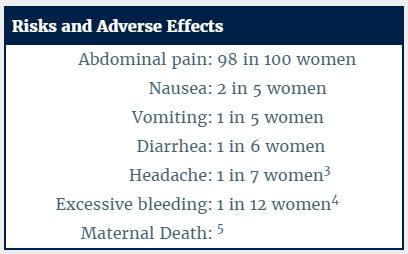Share Video:
Abortion Pills
First Trimester Medical Abortion
A medical (or chemical) abortion is a non-surgical form of abortion in which the woman takes pills containing Mifepristone (RU-486) and Misoprostol (or Cytotec) to end the life of the baby. This procedure is performed during the first trimester of pregnancy. The drugs are approved by the FDA for use up to ten weeks since the first day of her last menstrual period (LMP).

The woman visits an abortion clinic or doctor’s office and ingests pills containing Mifepristone (also known as RU-486) at the clinic. This drug blocks the action of the hormone called “progesterone,” which is naturally produced by the mother’s body to enable the mother to sustain and nourish the pregnancy. When RU-486 blocks progesterone, the lining of the mother’s uterus breaks down, cutting off blood and nourishment to the baby, who then dies inside the mother’s womb. Twenty-four to forty-eight hours later, the woman ingests another drug called Misoprostol (also called Cytotec), administered orally or vaginally, which causes contractions and bleeding to expel the baby from the womb.
The Food and Drug Administration (FDA) specified exactly how the drug regimen was to be given.
There is usually limited medical supervision for the woman during a medical/chemical abortion. Prior to the abortion, she should receive an exam that includes an ultrasound in order to confirm the pregnancy and diagnose any complicating factors, such as a tubal or ectopic pregnancy.
After taking the first pills (Mifepristone/RU-486) in the clinic, she is sent home to complete the abortion. This means she must correctly follow the directions for taking the remaining set of drugs and is responsible for judging whether her body’s reaction to the abortion is normal or not (such as a dangerous loss of blood). With this type of abortion, it is likely that she may not have a doctor to provide immediate help should a potentially life-threatening complication occur, so it is very important that she report any concerns to her doctor and seek emergency help if necessary.
The woman will also be responsible for disposing of her child’s remains. While she could lose her baby anytime and anywhere during this process, the woman will often sit on a toilet as she prepares to expel the remains, which she will usually then flush— she may even see her dead baby within the pregnancy sac.
It is also important that the abortionist perform a follow-up exam and ultrasound to ensure that the abortion is complete.
If a mother changes her mind after taking RU-486, she might still be able to save her baby, especially if she has not yet ingested the second drug, Misoprostol. To increase her chances of saving the baby, progesterone must be administered as soon as possible to counteract the effects of RU-486. Helpful guidance, resources, and stories of successful abortion pill reversals are available at abortionpillreversal.com.
Get HelpIn the short term, RU-486 and Misoprostol cause severe cramping, contractions, and heavy bleeding, which force the dead baby out of the mother’s uterus. Contractions and bleeding to expel the baby can last from several hours to several days, and can be very intense and painful. Many women also experience nausea, vomiting, diarrhea, abdominal pain, and headache.1 Maternal deaths have occurred, most frequently due to infection and undiagnosed ectopic pregnancy.2

Even after the baby is expelled, the bleeding and spotting may continue for several weeks. Bleeding usually lasts 9 to 16 days. Eight percent of women (1 in 12) bleed more than 30 days, and 1 percent require hospitalization because of heavy bleeding.6
About 5-8 out of 100 women (5-8%) may need a surgical procedure to complete the abortion or to stop too much bleeding.7

There is insufficient reporting on the long-term effects of medical abortions. Approval for RU-486 in the United States only extends back to October, 2000, and long-term effects and risks must still be evaluated. This means women who undergo medical abortions could be prone to unknown risks.
There are studies that indicate the risk of depression, anxiety, and suicide is greater for a woman who aborts an unwanted pregnancy than it is for a woman who carries an unwanted pregnancy to term.9
- Von Hertzen, H, et al. “Misoprostol Dose and Route after Mifepristone for Early Medical Abortion: A Randomised Controlled Noninferiority Trial.” British Journal of Obstetrics and Gynaecology, June 18, 2010. <onlinelibrary.wiley.com/doi/10.1111/j.1471-0528.2010.02636.x/full>.
- Ellertson,Charlotte, et al. “Can women use medical abortion without medical supervision?” Reproductive Health Matters, Vol. 5, No. 9, Abortion: Unfinished Business, May 1997, pp. 149-161. <http://www.rhm-elsevier.com/article/S0968-8080(97)90019-7/abstract>.
- Von Hertzen, H, et al. <onlinelibrary.wiley.com/doi/10.1111/j.1471-0528.2010.02636.x/full>.
- Food and Drug Administration. “MIFEPREX (mifepristone) Tablets, 200 mg.” accessed 19 Jan. 2016. <http://www.accessdata.fda.gov/drugsatfda_docs/label/2009/020687s015lbl.pdf>.
- Grimes, D.A. “Risks of mifepristone abortion in context.” Contraception, Vol. 71, 2005, p. 161. <https://www.arhp.org/uploadDocs/journaleditorialmar2005.pdf>.
- Food and Drug Administration. “MIFEPREX (mifepristone) Tablets, 200 mg.”, <http://www.accessdata.fda.gov/drugsatfda_docs/label/2009/020687s015lbl.pdf>.
- Food and Drug Administration. “MEDICATION GUIDE Mifeprex.” accessed 19 Jan. 2016 <http://www.fda.gov/downloads/Drugs/Drugsafety/ucm088643.pdf>.
- Food and Drug Administration. “MIFEPREX (mifepristone) Tablets, 200 mg.”, <http://www.accessdata.fda.gov/drugsatfda_docs/label/2009/020687s015lbl.pdf>.
- Fergusson, David M with Joseph M. Boden and L. John Harwood. “Does abortion reduce the mental health risks of unwanted or unintended pregnancy? A re-appraisal of the evidence.” Australian & New Zealand Journal of Psychiatry, Sept. 2013, Vol. 47, No. 9, pp. 819-827. <http://www.ncbi.nlm.nih.gov/pubmed/23553240>.
The failure rates for medical abortion increase as the pregnancy progresses.
According to the FDA’s assessment, using published and unpublished studies, the failure rate of RU-486 rises to over 7.3% when administered in the 10th week. This is more than three times higher than their assessed failure rate for RU-486 abortions in the 7th week.
Other studies have recorded even higher failure rates for medical abortion. The Von Hertzen study found failure rates of 5% at seven weeks and under, 8% at eight weeks, and 10% at nine weeks.
- Von Hertzen, H, et al. “Misoprostol Dose and Route after Mifepristone for Early Medical Abortion: A Randomised Controlled Noninferiority Trial.” British Journal of Obstetrics and Gynaecology, June 18, 2010. <onlinelibrary.wiley.com/doi/10.1111/j.1471-0528.2010.02636.x/full>.
- Von Hertzen. <onlinelibrary.wiley.com/doi/10.1111/j.1471-0528.2010.02636.x/full>.
During this stage of pregnancy, the preborn child is developing rapidly. At four to five weeks LMP — that is, four to five weeks since the first day of the mother’s last period, and just two to three weeks following fertilization (conception) — the baby’s organs start to develop, and the heart begins to beat. These developmental milestones often take place before the mother even knows she is pregnant.

Week 8
At eight weeks LMP, the preborn baby’s hands and feet are developing, and the neural pathways in her brain start to form. The child is constantly moving in the womb, although the mother cannot feel it. Source: Baby Center.

Week 9
By nine weeks LMP, the child can suck her thumb, open and close her jaw, stretch, and sigh. The baby’s teeth begin to form and the heart completes dividing into four chambers. Source: Baby Center.

Please note: This website has been researched and reviewed by physicians for medical accuracy; however, it is not intended to constitute medical advice or replace the individualized counsel of a doctor.
